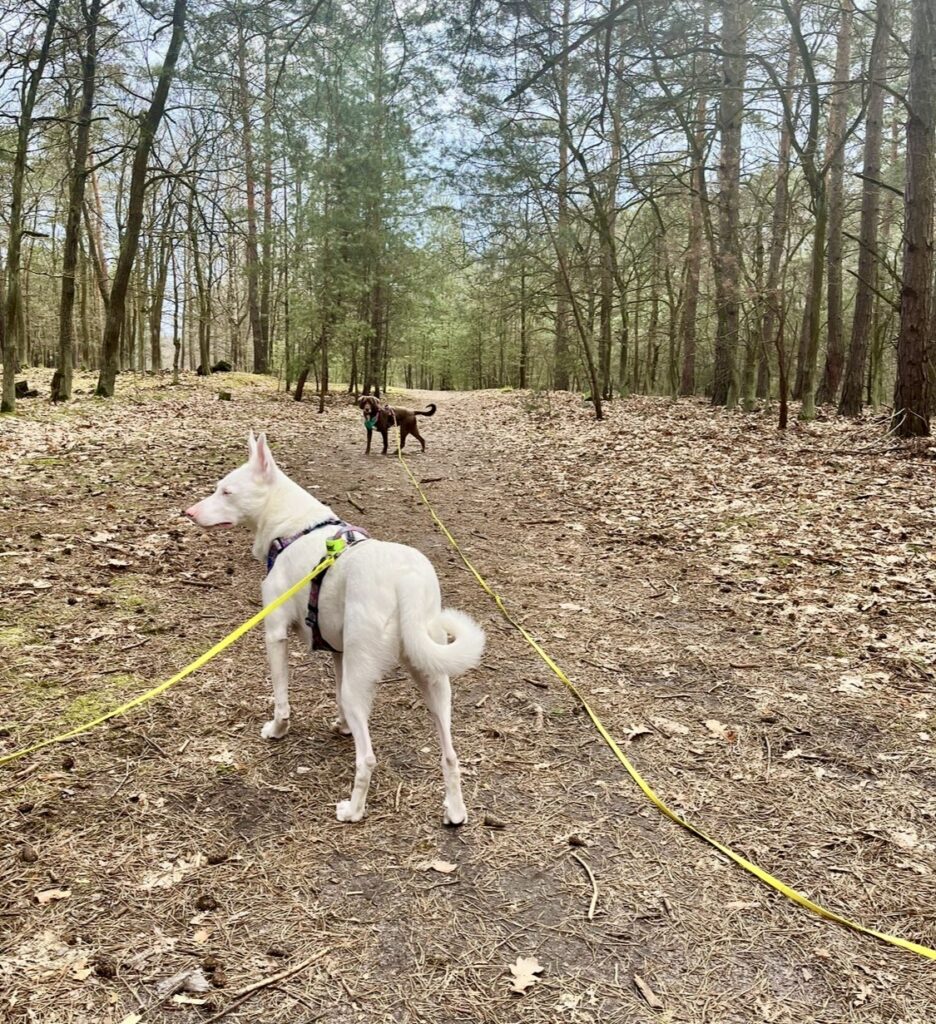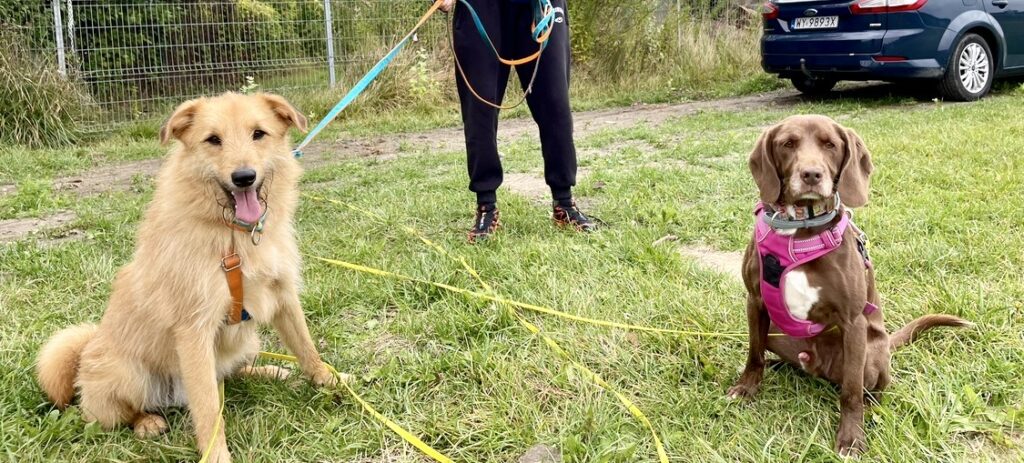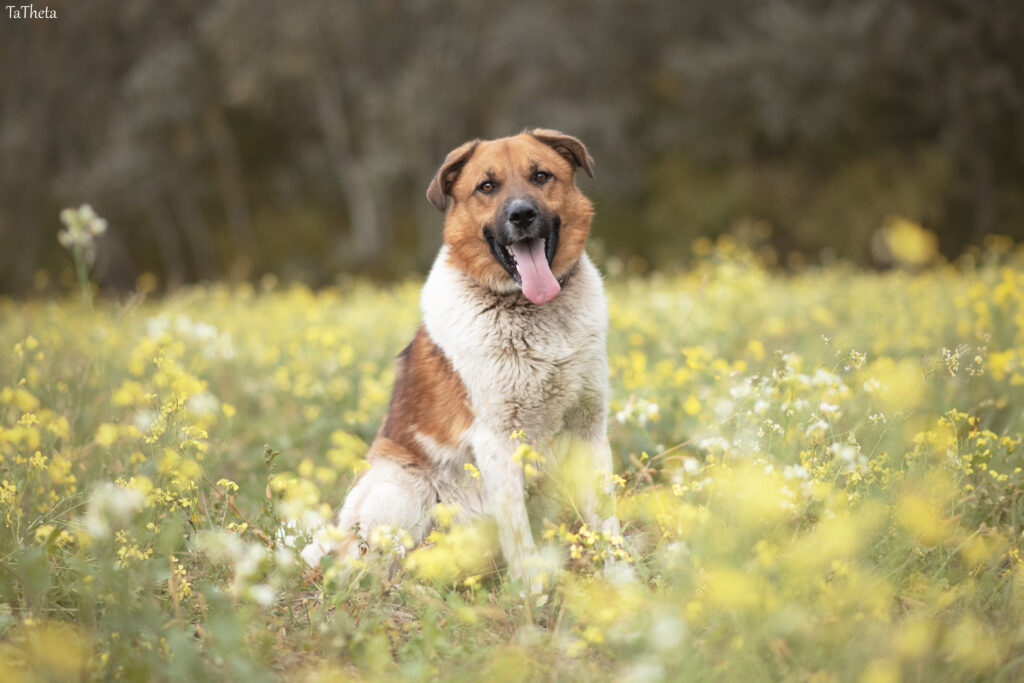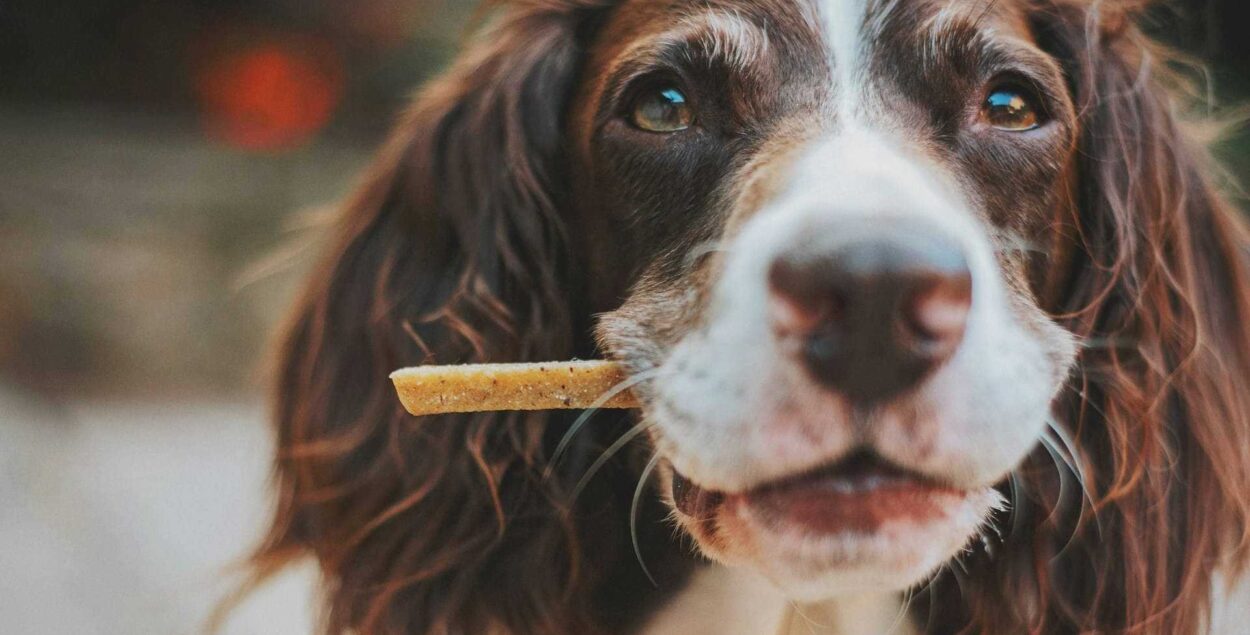How should you react on dog encounters during walks? Understand your dog’s behaviour
Imagine this situation: you’re out for a walk with your dog. In the park, you see another dog approaching; one you don’t know. Together with the other Guardian, you decide to let the dogs off their leads, and both begin to run and chase each other energetically while you watch their antics. You comment that the dogs are playing beautifully. Idyllic, isn’t it?
Unfortunately, I’m here to stir things up a little and ask, somewhat provocatively, whether ‘play’ is always play? Can unfamiliar dogs really play together straight away, and should we always let them? What’s the deal with those ‘weird dog people’ who hide with their dogs in the bushes, ask you to put yours back on the lead, and, when you kindly say ‘but mine just wants to play!’, look at you as if you have rabies? Let’s explore the answers together!

Does a dog need to meet other dogs?
Yes, yes, and once again, definitely YES, but… there has to be a ‘but’. Dogs are social animals, just like humans, and they need social contact. However, because every dog’s temperament – and therefore needs – are different, socialisation shouldn’t follow a fixed pattern. It should be tailored to the individual.
Different needs in terms of intraspecific contact – what does that actually mean? It’s not only humans who can be ‘extroverts and introverts’ – though that’s quite an oversimplification. Think of that friend of yours who’s always full of energy, even at six o’clock on a Monday morning, never says no to meeting for coffee, is ready every weekend for a trip or a party with friends, and when they need support, they call someone close to talk and instantly feel better. They bring to mind a perpetually cheerful, slightly hyperactive Golden Retriever who wants to invite everyone to play with their cuddly toy. Now, for contrast, imagine that friend who prefers small gatherings in quiet places and would rather read a book by the fire than dance the night away. If they were a dog, they’d probably be a shy and slightly withdrawn rescue from a shelter; one who needs plenty of time to form a new bond. Dogs, just like us, differ in confidence, past experiences, energy levels, temperament and, above all, individual preferences for spending time with others.
Your dog’s needs might include calm, shared sniffing sessions with canine companions and steady exploration of the area, while your neighbour’s much younger dog may be looking for a partner for wild, boisterous play. No wonder they might not become best friends – after all, you probably don’t share many interests with a neighbour twenty years younger than you, right? The key to success is learning canine communication well enough to recognise the signals that show how your dog feels during an interaction. This way, you’ll be able to find them suitable companions and help set boundaries with those pushy types who drain your four-legged friend’s social battery.

Contact with other dogs – how to do it wisely and socialise your dog
First of all, remember that just as you don’t like every person you meet, your dog also has the right not to want to be friends with every dog they encounter. They may even have their enemies and best friends; so as long as the sight of another dog doesn’t trigger intense fear or aggression in your dog, having likes and dislikes is perfectly normal.
Bear in mind that we don’t enthusiastically hug every person we meet on the street. In fact, we don’t even say ‘good morning’ to most of them, and when passing dozens or even hundreds of people each day, we often feel no need to make eye contact. No animal should therefore be expected to engage in close interaction with every member of its species – unless both parties actually want to. Otherwise, dogs should not be forced to ‘say hello’, and any requests for distance should be respected, as we can never know what issues the other dog and their Guardian may be dealing with.
Following the thread of human-canine comparisons, picture your circle of good acquaintances and close friends. Some of us feel comfortable with one close companion, others have a small group of friends, and someone else may have thought of a dozen favourite mates. Most likely, however, none of us imagined an entire army of people in whose company we relax and have fun. Likewise, dogs should have a stable circle of canine friends they see regularly, while random encounters on daily walks should be treated as an addition. It’s impossible to define precisely how many planned and how many spontaneous interactions with other dogs will meet your dog’s social needs – and how many will be excessive, leading to constant tension and overstimulation. Try to observe your pet closely to assess which dogs they feel most comfortable with. If you’re unsure or don’t know how to begin building your dog’s social skills, a behaviourist will certainly help.
Let’s remember – quality matters more than quantity. However, if your companion is aggressive or fearful, and the mere sight of an approaching dog makes both your hearts race, it’s worth consulting an animal psychologist or behaviourist.
If you’re the Guardian of a puppy, make sure to take special care in arranging thoughtful interactions with other dogs, as experiences from puppyhood will shape their future relationships within their species. Meeting calm, older dogs who will teach them ‘how to speak dog’ and show them clear rules of canine etiquette is extremely important.
A walk with your dog – the golden rules
HIT or MISS? How and where should you introduce dogs, and what (and who!) should you avoid?
Do not introduce dogs while on a short lead – limited ability to move, walk away, or even escape causes stress and may lead to the escalation of fearful or reactive behaviours. If circumstances do not allow your dog to be off lead, you are unsure whether you will be able to call them back to you, or you want to be able to separate the dogs if necessary, make sure to keep the lead loose and avoid excessive interference that could disrupt canine communication.
Be your dog’s advocate and do not be afraid to support them if the situation calls for it. In practice, this means that if you see your pet does not want contact with another dog, is afraid, or is being bullied by another animal – do not leave them alone in that situation. Stay close so your dog can see you as a safe base, and if they hide behind you, help them create distance from the intruder. Also remember that dogs are autonomous beings who deserve to have their personal space respected. You therefore have every right (and towards your charge – even the duty) to communicate to others whether you and your dog wish to be approached and/or touched, or not.
Avoid narrow paths and alleyways, as well as crowded parks and meadows, if you want to introduce dogs to one another. Dogs communicate mainly through body language. They therefore need space to be able to approach each other without misunderstandings or excessive excitement. A long (10–20m) training lead will allow you to give your dog enough freedom to communicate in an open area while still maintaining the ability to stop them if needed.
Keep moving! Movement is not only about health, but it also supports effective canine communication. Dogs communicate through body language and, importantly, through scent! Gathering each other’s scents from a safe distance and marking with urine, paws, or by rolling are key elements of initial information exchange. Standing still does not encourage this and may lead to tension and stress, whereas when walking, it is much easier for a dog to manage distance and both gather and leave ‘scent messages’. A shared walk undoubtedly beats standing in a circle of dogs and people in the park.
Definitely avoid dog enclosures and play areas – unless they happen to be empty and you can use them for your dog to explore interesting smells. Such places do not allow for body language communication at a distance, nor for moving around enough to exchange scent-based information. Besides, an individual dog’s scent marker is quickly lost among countless others. There is no chance of calm introductions or consciously choosing suitable canine company in such an environment. Limited space and many dogs are a recipe for conflict and competition over scarce resources – and that has little to do with play.
‘So where am I supposed to find friends for my dog if not at the dog park?’ I’m glad you asked! A valuable alternative would be socialisation walks organised by a professional. During such walks, a behaviourist ensures proper selection of dogs, small groups, and calm introductions and interactions. Such a walk will also be a treasure trove of knowledge about canine communication for every Guardian! And who knows – you might even meet some lovely fellow dog enthusiasts along the way.
Canine etiquette – how to read dog behaviour
If there were ‘Ten commandments of polite dog conversations on walks’, it might look like this:
- Distance eases manners – give dogs time to observe one another and ‘talk’ from a distance. Most canine conversations happen through body language and by gathering or leaving scent messages. Space is essential for this. Standing side-on to another dog, sniffing the air and the ground (so-called upper and lower air-scenting), marking with urine, paws or by rubbing against surfaces, as well as rolling on them and sniffing those areas in return – all of these are behaviours that form part of gathering information about one another.
- Polite dogs approach in an arc – this may sound humorous, but approaching another dog directly head-on can be seen as breaking the rules of canine etiquette and an attempt to initiate confrontation. Allow dogs to approach each other in an arc, or use an arc to avoid dogs and people you do not wish to meet. This will reduce the chances of barking or other signs of agitation.
- Uninterrupted chasing, constant pursuit of one dog by another (or several others), repeated jumping on the Guardian and/or the dog hiding behind their legs – these are red flags, not signs of good fun! It’s time to go home.
- A dog’s ‘play bow’ can have several meanings, and most of them are requests to stop or attempts to create distance. If performed stiffly, intensely, with paws slapping the ground, it is unlikely to be an invitation to play.
- A wagging tail does not guarantee a positive interaction and does not necessarily mean happiness! A tail can wag in many different ways, but generally, it signifies emotional arousal, which might be joy and excitement – but not always. It may just as well be linked to arousal caused by another emotion, such as frustration, stress, or even anger. Wagging the tail should always be interpreted together with other body language signals from the dog.
- Does licking always mean affection? Of course… not! Licking can have a deeper meaning – surprisingly, it can be a polite request for distance. Intense licking of your hand or face, combined with body or facial tension, may be your dog’s very civilised way of saying, ‘please stop touching or kissing me’. When directed towards another dog, it might mean ‘I like you, but please give me some space’. Persistent licking of another dog’s muzzle, if unwanted, can be an attempt to pressure or control them and is a breach of ‘canine etiquette’. It can be, but does not have to be – everything depends on context and accompanying signals.
- Let’s say it clearly: there is nothing wrong with dogs sniffing each other’s bottoms! It is a completely normal and very important part of canine introductions, and we should not interfere with it.
- Let’s go a step further and not demonise sniffing or even licking other dogs’ urine. That too is entirely normal! These ‘pee messages’ contain a wealth of information about another dog’s emotions, sex, health, fertility, and more. Additional paw marking after toileting – as paws also contain glands – strengthens the dog’s scent message about themselves.
- Another unpopular opinion – growling is great! A dog growls so they don’t have to bite – really! It’s a warning to us or another dog that something is making them uncomfortable, giving a chance to react before they feel the need to use their teeth. We should never punish a dog for growling but instead consider why they are doing it and how we can help – perhaps they’ve had enough of their playmate and it’s time to go home?
- Wild chases and wrestling matches are not the only form of dog friendship. We don’t always go clubbing or to the gym with our friends – sometimes we just want a calm walk or a chat. It’s the same for dogs. A peaceful walk full of shared sniffing and exploring is just as valuable – if not more so – than rough play and running. In good company, it has a calming, regulating effect on both canine and human nervous systems.

Is it play or dominance? How to tell the difference
To assess whether we are dealing with genuine play or another form of interaction, we have to always evaluate each situation individually – taking into account the context, conditions, the ‘length’ of the dogs’ acquaintance, and their personality traits. However, there are several guidelines we can follow to help determine whether our dog is truly playing with another dog.
- Good play should be balanced. This means we should see role reversals – sometimes one dog chases while the other runs away, and sometimes the roles are swapped. The division of roles doesn’t have to be perfectly even, but for example, if our dog is always the one running away, it’s worth considering whether the interaction is bringing them as much joy as it does to the chaser.
- Not everything in good play has to be ‘full-on’. Self-handicapping behaviours – when a dog, for example, allows their playmate to roll them onto their back even though they are stronger, or runs slowly enough for the other dog to catch up rather than sprinting at full speed – often indicate that we are witnessing play, not a show of dominance, competition, or the start of a conflict.
- Play should include breaks – for catching breath, checking in with the Guardians, or some joint or individual sniffing. Dogs should be able to initiate such breaks themselves and signal the end of play – without intervention from their Guardians – and both parties should be equally willing to return to play after the break. If this doesn’t happen, it may mean that emotions are running too high.
- It’s hard to define precisely, but the body language of dogs engaged in play should look ‘soft’. Stiffness, tension, frequent aggressive communication, constant and insistent barking, or seeking support through contact with the Guardian are warning signs that should make our internal alarm go off.
- If ‘play’ repeatedly escalates into conflict whenever it isn’t interrupted by the Guardians, it’s very likely that it was never genuine play to begin with.
- Usually – though not always – the best play happens between two dogs. It’s less common between three and even rarer in larger groups. If we’re observing group interaction, it’s worth paying attention to whether the larger group isn’t ‘bullying’ one or more of the dogs.
The most important thing to remember: dogs that don’t know each other are almost certainly not playing! Just as we don’t usually confide our deepest secrets to strangers or have as much fun with them (at least not sober) as we do with close friends we feel comfortable around, unfamiliar dogs will very rarely play with each other.
Two unfamiliar dogs, upon seeing each other, run towards one another, perform a ‘play bow’, and start running, jumping, and bumping into each other energetically. They’re not biting one another. So if that’s not play, then what is it?! Dogs get to know each other by testing boundaries and trying to show themselves in the best possible light – for example, by demonstrating how fast, agile, or strong they are. Early dog interactions can take the form of demonstrations of ability or competitive games – who’s better at what, who can take a resource away, which dog will move aside, and which will stand their ground, and many more. This kind of testing isn’t necessarily bad, as it can be the first step towards a canine friendship. However, there are a few BUTs: to ensure that such demonstrations don’t cause excessive stress for our dog or that competition doesn’t turn into open conflict, we have to be able to distinguish this kind of play from genuine play, support our dog if the ‘rival’ turns out to be too difficult to deal with, and help our dog leave the situation if needed.
Our support is a key element in developing our dog’s social skills – which is why learning about canine communication is so important!

Regardless of whether you choose adoption or a dog from a breeder, make your choice consciously. Mutual compatibility is the key to shared happiness. If you decide to choose a mongrel, visit the websites of ‘Na Paluchu’ shelter (Schronisko Na Paluchu) and the ‘Friends of Paluch’ foundation (Fundacja Przyjaciele Palucha) to find out how to adopt responsibly.
Did someone say ‘socialisation walk’? Grafi, our special agent, is reporting for duty! This handsome resident of ‘Na Paluchu’ shelter definitely ‘speaks dog’ and always enjoys meeting new canine friends. Although Grafi is a bit more sceptical towards new people, he becomes a wonderful walking companion for anyone who earns his trust. A companion for walks and baths, because Grafi is a true connoisseur of water-and-mud bathing – for his health, of course! If you fancy going for a walk (or a swim) with Grafi, be sure to visit his profile – Grafi 2032/22 | Schronisko Na Paluchu – and call the volunteers!
